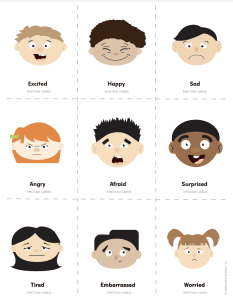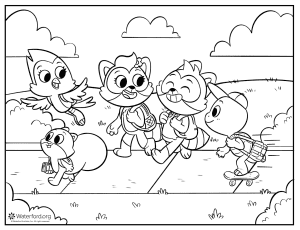Autism spectrum disorder (ASD) is a neurodivergent condition that affects communication, behavior, and learning. Psychologists use the term spectrum disorder because symptoms and support needs vary depending on the child. Although clinically defined as a disorder, having autism does not mean something is wrong or “needs to be fixed” with a child; it means their brain is wired in a different way from what is considered more common or neurotypical.
A few common signs of autism include:
- Difficulties reading and reciprocating neurotypical social cues
- Intense, repetitive behaviors and interests
- Sensitivity to visual, auditory, and/or other sensory stimuli
Autistic individuals make up about 2% of the population, a figure that has risen in recent years as clinicians have gotten better at recognizing symptoms and have integrated conditions that used to be considered distinct like Asperger’s syndrome and PDD-NOS into one diagnosis spectrum. This means that about 1 in 36 of the children you teach will be diagnosed with autism.
Want to better support students with autism at your school? Read on to find 24 tips and lesson ideas for supporting children with autism.
Social Skills Activities for Elementary Students with Autism
Students with autism often have trouble interpreting and mirroring neurotypical social cues; the same is true of non-autistic students for interpreting and responding to autistic social cues. While both autistic and non-autistic students often feel empathy for each other, they don’t always know how to communicate in a way their peers with a different neurotype understand. This is known by psychologists as the double empathy problem.
The activities below can help autistic and non-autistic students gain social skills that help them empathize with their peers and recognize emotional cues in themselves.
Remember that not all children may be comfortable speaking or sharing in groups. Follow the child’s lead to see where their comfort level is.
 1. Emotion Cards
1. Emotion Cards
These printable cards (available in Spanish here) can help your students learn how to recognize different emotions in themselves and others. Cut out each one with scissors and shuffle them in a deck. Then, go through each card and see if your student can recognize the emotion without looking at the word.
If they get stuck, that’s okay—just show them the word and give them context for the emotion shown. If the card is “embarrassed,” for example, you could say, “When a person is embarrassed, they might feel like they have done something silly by accident.”
You can also use these behavior cards (available in English and Spanish) to help children pair emotions with actions.
2. Sharing Time
Sharing time is a classic elementary school staple, and it can also be a great social activity for kids with autism, who often have passionate interests in specific subjects. Every week, have one student bring in something that they’d like to share with the class.
Remember to lead by example. To get started, show the class something you are interested in.
This activity will not only show students how to discuss their interests with others but also how to practice active listening. And if they’re fascinated by something another student brings in (or vice versa), they may even make a friend.
3. What Would You Do?
For a take-home empathy activity you can share with families, try this What Would You Do? game. Families can go through different scenarios together and decide how they would react with questions like “How would you help?” or “What would you say?”
4. Name Game
This fun group communication activity teaches students an essential skill: how to introduce themselves and learn someone else’s name. To play this game, gather your students in a circle so they can all see each other. Start by pointing at yourself and saying your name (“I am Mr. or Ms. _____.”). Then, ask the child on your right to share their name just like you did and then repeat your name while pointing at you. Have each child take turns saying their name, then pointing at another child in the class and repeating their name.
The Name Game is an especially fun social skills activity for children to do at the beginning of the school year. That way, they’ll be able to learn their classmates’ names and get a head start on making new friends.
5. “How Would It Feel to Be ____?”
Next time you read a book to your class, try asking your students how it would feel to be the main character in the story. If you’re reading a picture book about Cinderella, for example, you could ask how they would feel if they had two stepsisters who were mean to them. Or if you’re reading Peter Pan as a class, you could ask them what happy memories they would think about to fly with magic pixie dust.
This can help students practice empathy and see situations in their life from another perspective—a useful skill for communicating with people of a different neurotype. It can also teach them how to recognize emotional cues by encouraging them to put themselves in the perspective of another person.
Sensory Activities for Children with Autism
Children with autism are often over- or under-sensitive to sights, sounds, and other sensory stimuli. Specific sensitivities and accommodation needs vary depending on the individual. Keep these resources in mind as you get to know the students with autism in your class to help support their sensory needs.
6. Fidget Toys
Fidget toys are a well-known sensory tool for helping children with autism stay emotionally regulated and focused. Depending on your available resources, you can either stock your classroom with a few fidget toys or make some of your own.
We Are Teachers has compiled a list of fidget toys you can make on a budget with your students. From classics like fidget spinners to repurposed pipe cleaners or popsicle sticks, you’re sure to find something useful for your classroom.
7. Sensory Sound Resources
When the phrase “sensory play” comes up, visual or tactile activities usually come to mind first. Autism Adventures, however, suggests including activities and resources that involve sound or aid in noise reduction—with a few examples to help you brainstorm class activities or accommodations:
- Musical chairs
- White noise machine
- Simon Says
- Noise-canceling headphones
- Rhythm instruments like shakers, rain sticks, or drums
 8. Sensory Bin
8. Sensory Bin
Sensory bins can be useful for two reasons. First, they encourage independent play, which can have academic benefits for students. And second, they’re a straightforward and accessible sensory experience for students with autism.
Little Bins for Little Hands has put together a few useful tips for making your own sensory bin. Use them as a guide to set up a sensory bin that will best accommodate your students’ needs.
9. Sorting with Snacks Activity
This tactile activity for children with autism can be a fun way to engage students during math time. Give everyone in your class food that is easy to sort, like chewy snacks or small crackers. Multicolored snacks are ideal, but you can also use food that comes in different shapes, textures, or sizes.
First, ask them to sort the food by color, shape, or another characteristic. Then, use the snacks to teach students basic math skills like counting, addition, or subtraction. Once they’ve grasped the concept you want to teach, reward your students by letting them eat the snack.
10. Scientific Slime Experiments
Slime is not only a popular craft for young children but also a great sensory activity for autism in class. There are plenty of simple slime recipes online. Look up your favorite and have fun making it with your students. You can use this as a tactile art activity if you’d like or as a STEM activity for elementary students.
Calming Activities to Help Students with Autism Regulate Emotions
Many people with autism experience difficulty with self-regulation, especially as children. This can lead to moments of emotional or sensory overwhelm known as meltdowns or moments of withdrawal known as shutdowns.
If your student with autism is experiencing distress, these activities can aid them with self-regulation.
 11. Coloring
11. Coloring
According to a partner article by The National Institute for Trauma and Loss in Children published by We Are Teachers, coloring pages can be a great mind-body exercise for calming down and focusing on the here and now.
Keep a few coloring pages on hand, and suggest them as a calm-down activity when your students are overwhelmed. For a few free coloring pages to get you started, check out these printable Waterford resources:
12. Calm-Down Cards
If your student with autism struggles with emotional regulation after experiencing strong feelings, calm-down cards can be a helpful resource. A mother of a child with autism created a how-to on creating your own calm-down cards at And Next Comes L.
Each card has a helpful idea for calming down after a stressful moment. Plus, the author notes they can also be useful for children with anxiety.
13. Mindfulness Exercises
Mindfulness is a technique that encourages children to keep their mind in the present and deal with uncomfortable emotions. If your student is struggling to calm down, try mindfulness activities like breathing exercises to help them self-regulate.
14. Grounding Techniques
Grounding techniques are designed to help us focus on the present during stressful situations. Here are a few grounding activities for kids with autism to try if they are overwhelmed:
- Count to ten or recite the alphabet as slowly as you can
- Listen to calming music and pay attention to the different instruments
- List five different things that you can see around the room
- Try stretching or simple yoga exercises and focus on how your body feels
- Hold something tactile like a piece of clay or a stuffed animal
15. Student Retreat Zone
When a student with autism is overwhelmed, giving them a place where they can relax and take a break from sensory stimulation can sometimes go a long way. Designate a corner of your class as the “Student Retreat Zone” and fill it with sensory toys, picture books, comfortable seats, and calming activities that students could do on their own.
Let every student in your class know that if they feel anxious or stressed, they can always take a few minutes to decompress in the Student Retreat Zone. That way, you don’t have to single out your student with autism but you can still let them know that it’s an option. If your student with autism seems like they could use some time away from class, you could also ask them if they’d like to read or work on homework in the library for a while.
16. Calm Down Kit
Tactile toys can help children with autism calm down if they’re overwhelmed. Fill a drawer in your classroom with toys that could help them self-regulate. When your student seems stressed or has trouble focusing, ask them if they would like to pick a toy from the calm down drawer.
Here are a few ideas for sensory toys to put in your calm down kit:
- Play dough
- Fidget toys
- Stress balls
- Weighted blankets
- Aromatherapy pillows
Effective Teaching Strategies for Children with Autism
You may have heard the phrase, “If you’ve met one person with autism, you’ve met one person with autism.” Every child is different, and the teaching strategies you use will need to take their support needs into consideration. That being said, these strategies can help you be mindful of common accommodations and resources that can help students with autism feel comfortable in class. Many can also be helpful to engage children without autism in your lessons.
 18. Bring Special Interests into Lesson Plans
18. Bring Special Interests into Lesson Plans
Many children with autism have an intense passion for certain topics or activities. This is often called a special interest. Take advantage of what they’re passionate about and use it while teaching students with autism to help them focus in class. If a child with autism loves outer space, for example, you could plan a math assignment about counting the planets in our solar system.
19. Use Visual Learning Aids
Many, though not all, kids with autism are visual thinkers. Renowned scientist and autism advocate Dr. Temple Grandin once said, “I used to think adults spoke a different language. I think in pictures. Words are like a second language to me.”
Lessons that include visual aids can help students with autism who have this learning style grasp concepts more naturally. You could, for example, teach children with autism sight words with magnet letters.
20. Create and Share a Daily Classroom Routine
Routines make children with autism feel safe and help them prepare for transitions between activities. Post your daily class schedule in your room for every student to see and, if possible, provide extra transition time to students with autism.
21. Hold a Professional Development Session on Autism for Educators
It’s important to teach faculty about supporting students with autism. If you’re a school administrator, hold a professional development session on teaching students with autism led by a specialist. Teachers, consider requesting a professional development opportunity so administrators know there is interest in your district.
Activities for Autism Acceptance Month in April
April is Autism Acceptance Month! Use these activities to make sure your curriculum includes autistic representation year-round and to get ideas for observing this awareness month in elementary schools.
22. Autism Bulletin Board
The puzzle piece is a popular autism awareness symbol, but many neurodiversity advocates feel that it spreads the idea that autistic people are missing something or incomplete compared to neurotypical people. Instead, the infinity symbol is used to represent the diversity in experiences of neurodivergent people.
Decorate your classroom bulletin board with a colorful infinity symbol to spark conversation on neurodivergence and help students with autism and their families feel welcome and accepted.
 23. Teach Students About Famous and Historical Autistic Figures
23. Teach Students About Famous and Historical Autistic Figures
Educate students on autistic people in history and the present day to give students with autism curriculum that mirrors their experiences and offer neurotypical students a window into experiences that are different from their own. This is important to do not just in April but throughout the year.
Here are a few well-known autistic people or historical figures believed by psychologists to have autism to get you started:
- Greta Thunberg – Climate change activist
- Temple Grandin – Animal behaviorist, author, and autism advocate
- Thomas “Blind Tom” Wiggins – Nineteenth-century piano prodigy and composer
- Sir Isaac Newton – Mathematician, physicist, astronomer, alchemist, and author
- Hans Christian Andersen – Fairy tale author, artist, and storyteller
24. Read a Picture Book About Characters with Autism
Reading picture books about characters with autism is another way to help autistic students feel seen and give neurotypical students a window into different experiences. Keep these picture books about characters with autism in mind for read alouds or to include in your classroom library:
- The Girl Who Thought In Pictures: The Story of Dr. Temple Grandin by Julia Finley Mosca
- My Brother Charlie by Holly Robinson Peete
- Different Like Me: My Book of Autism Heroes by Jennifer Elder
- This Beach is Loud! by Samantha Cotterill
- Trampoline Boy by Nan Forler

Waterford Reading Academy: A Certified Autism Resource
Waterford’s early reading curriculum is a Certified Autism Resource (CAR), given by The International Board of Credentialing and Continuing Education Standards. It meets PreK-2 learners where they are and provides scaffolding to help learners gain proficiency in key literacy skills.
Follow the link here to learn more about Waterford curriculum and how it can support neurodivergent learners with explicit instruction based on the science of reading.
Andy Minshew is an educational content writer for Waterford.org. He has developed articles, ebooks, help instructions, and other Waterford resources for educators and families since 2018. He is also an Audiofile Magazine reviewer and a librarian advisor for EBSCO NoveList. He loves visiting art museums, participating as a member of the Tolkien Society, and hiking with his family.

